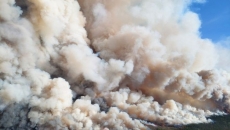An air and sea search continued Tuesday across hundreds of kilometres of ocean south of Newfoundland for a submersiblecarrying five people that vanished during a dive to the wreckage of the Titanic.
The search, in an area about 700 kilometres south of St. John’s, N.L., is in a race against time because the 6.4-metre vessel had a 96-hour oxygen supply when it submerged on Sunday morning, according to an adviser for owner OceanGate Expeditions.
The surface launch ship Polar Prince reportedly lost contact with the submersible named the Titan about an hour and 45 minutes into its dive.
In a tweet, the U.S. Coast Guard said the Polar Prince was continuing surface searches along with a second vessel, the Bahamas-flagged cable layer Deep Energy, while a Canadian military Aurora patrol aircraft was conducting sonar searches. U.S. search officials said two Hercules aircraft flights were completed overnight from the coast guard station in Elizabeth City, N.C.
As of Tuesday morning, the U.S. Coast Guard said the total search area completed was nearly 26,000 square kilometres.
Joyce Murray, minister of fisheries and oceans, told reporters in Ottawa that Canada’s coast guard was doing everything it could to support the U.S.-led search.
“We have the Canadian Coast Guard ship John Cabot. It has sonar and it is headed to the site,” Murray said. She said two other Canadian Coast Guard ships that had been at the scene are now in St. John's ready to transport equipment if necessary.
The minister declined to say whether any Canadian shore facilities had picked up any signals or pings from the Titan. “I will not go into details because this is a hugely emotional issue,” Murray said. She said additional search assets were also on the way from Great Britain and Germany to help in the effort to find the submersible.
Dr. Ken LeDez, an anesthesiologist with an expertise in hyperbaric and diving medicine, said the occupants are in a dire situation, especially if the submersible has lost power. “I feel the odds are stacked against them,” LeDez, of Memorial University in St. John’s, said in an interview. “My thoughts just turn to the kind of experience that they must be having right now."
If the vessel lost power, the five would be battling decreasing oxygen supplies and increasing carbon dioxide concentrations, all in complete darkness, said LeDez. The temperature inside the chamber would also likely be plummeting if the loss of electricity wiped out their heat source.
“If they just are sitting there and resting and taking it easy and waiting for rescue, that is going to use less oxygen and produce less carbon dioxide,” he said.
Newfoundland-based Titanic expedition expert Larry Daley said he’s holding out hope the submersible and its passengers will be found safe.
Daley made the trip to the famous shipwreck himself in 2003 aboard a Mir submersible. He said he was overwhelmed Monday when he heard the Titan was missing.
“I didn’t sleep at all last night,” he said in an interview Tuesday. “(It’s) very sad thinking about ... being trapped in a submersible at that depth, and hoping that it returns to the surface through whatever mechanism that triggers it.”
If that doesn’t happen, Daley said weather conditions this time of year are best suited for crews to be diving to the wreck to find the Titan. And Newfoundland, he said, is home to – or close to – many powerful rescue crafts that can assist with the search.
The search is being conducted in the Grand Banks and current weather conditions there are favourable, said David Neil, a meteorologist with Environment Canada in Gander, N.L.
As of early Tuesday afternoon, the largest waves in the area were between one and two metres high, and winds were moderate, Neil said in an interview. There may have been fog earlier in the morning, but it was expected to dissipate as the day wore on, he said.
“Conditions overall aren’t too bad,” Neil said, though he noted that winds could pick up later in the evening.
Those on board the submersible have yet to be formally identified by authorities, though some of the names have been confirmed.
British businessman Hamish Harding, who lives in Dubai in the United Arab Emirates, was one of the mission specialists, according to Action Aviation, a company for which Harding serves as chairman. Also on board were Pakistani nationals Shahzada Dawood and his son Suleman, according to a family statement sent to The Associated Press.
French explorer and Titanic expert Paul-Henry Nargeolet also was on board, according to David Gallo, a senior adviser for strategic initiatives and special projects at RMS Titanic.
The expedition was OceanGate's third annual voyage to chronicle the deterioration of the Titanic, which struck an iceberg and sank in 1912, killing all but about 700 of the roughly 2,200 passengers and crew.





